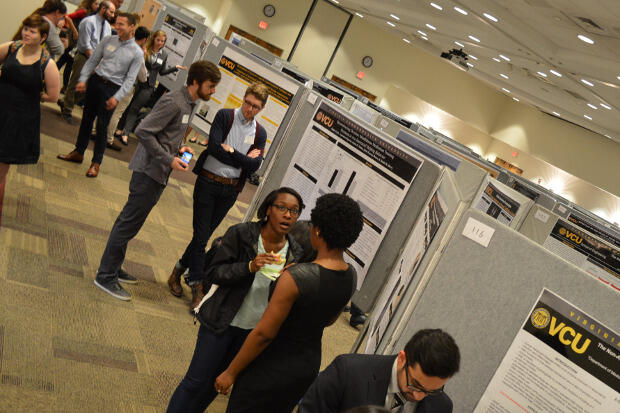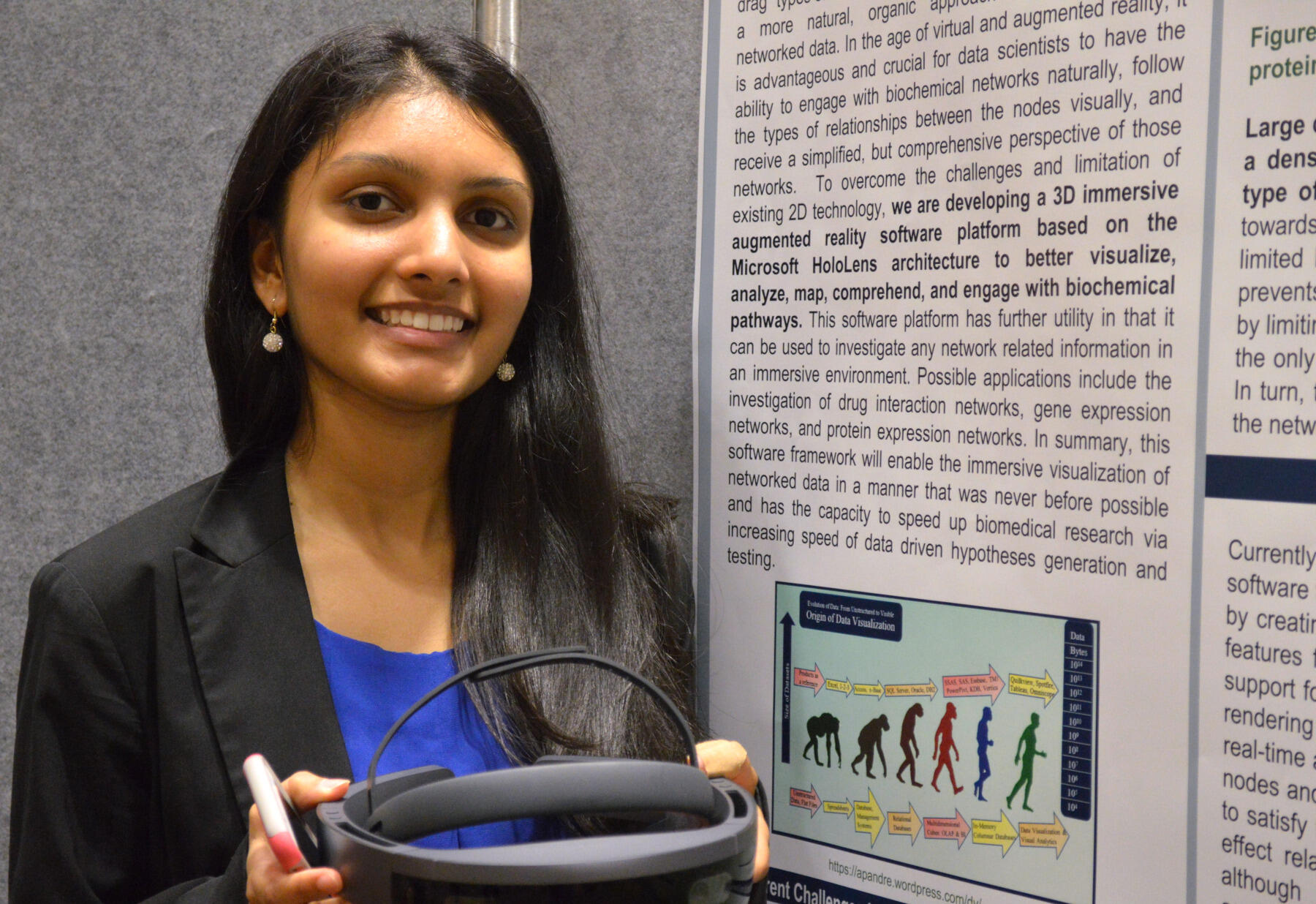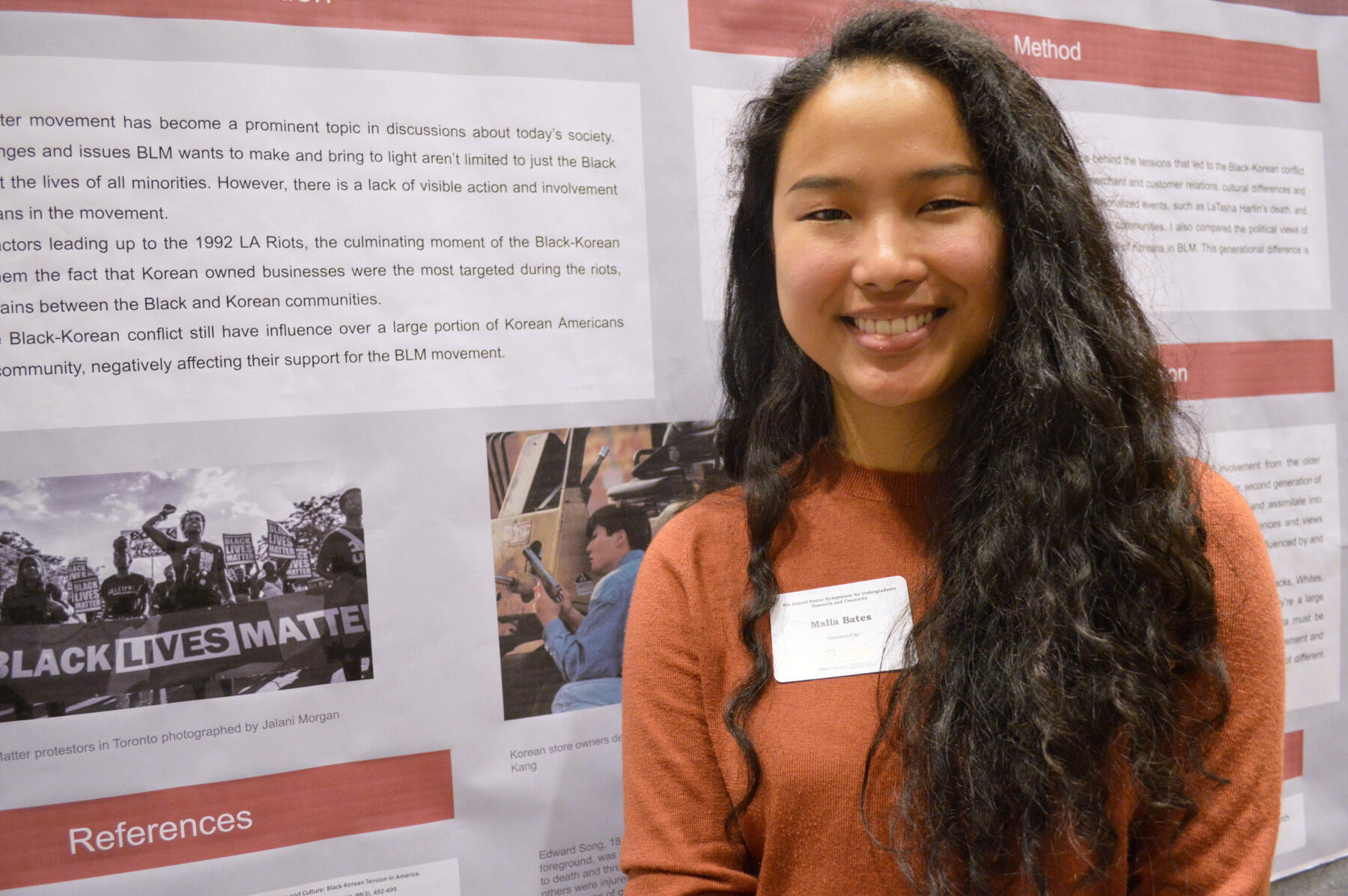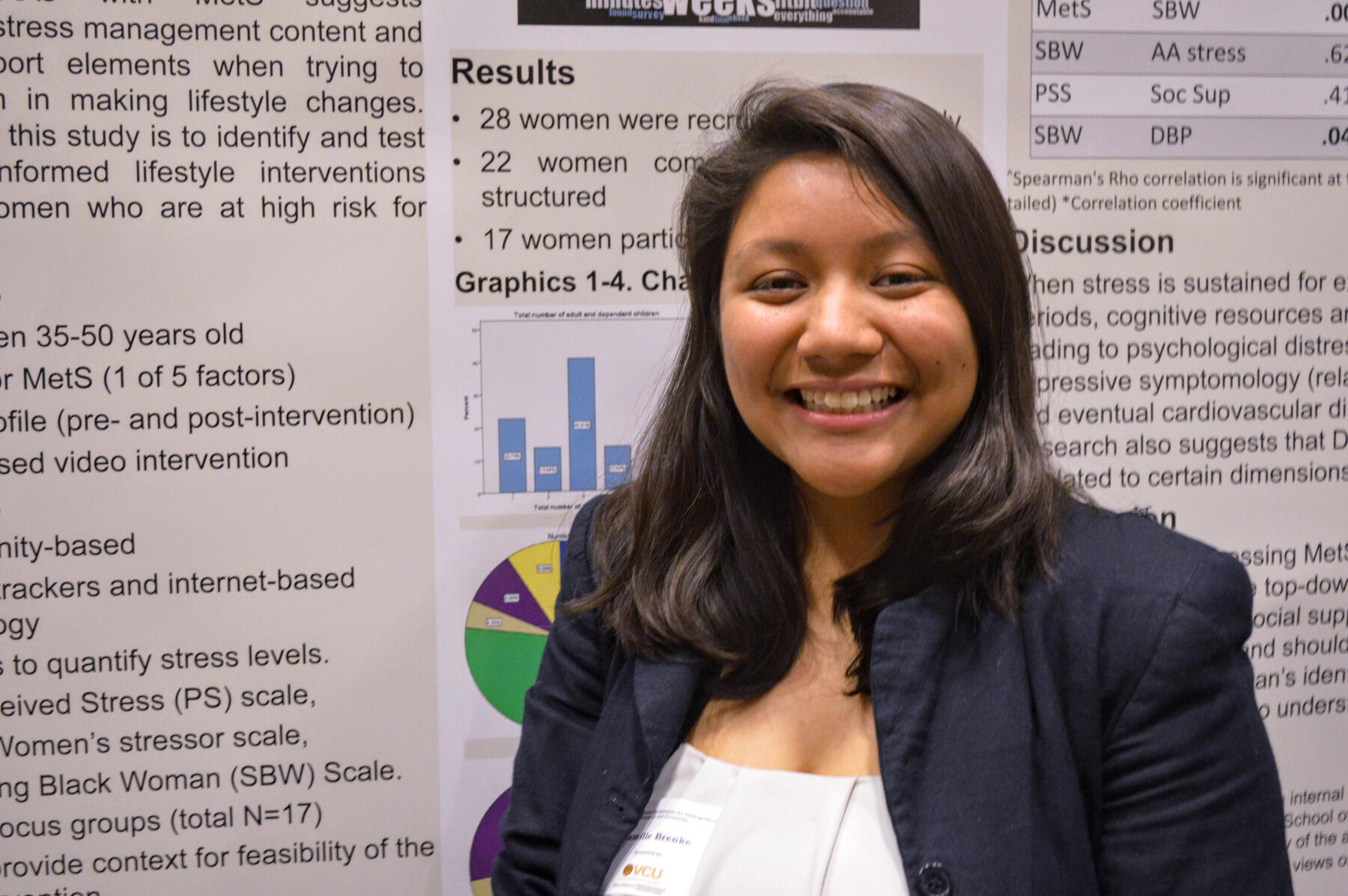
April 27, 2017
Undergraduate students show scholarship at the highest level at annual Poster Symposium for Undergraduate Research and Creativity
Share this story
For many Virginia Commonwealth University undergraduates, the Poster Symposium for Undergraduate Research and Creativity is a chance to proudly showcase the results of their first major research endeavor. The event is often a culmination of an undergraduate academic career, and marks the end of a year’s worth of exploration for a major research project.
Last week, more than 300 students participated in the symposium, sponsored by the Undergraduate Research Opportunities Program. The event is part of the seventh annual Research Weeks.
VCU News interviewed* several researchers about their work:
* Interviews are in the student’s words with edits by VCU News for clarity and brevity.

Learning in three dimensions
Project: “3-D immersive visualization of biochemical pathways”
Researcher: Bansri Rawal, sophomore, computer science and premedicine
Mentors: Dayanjan “Shanaka” Wijesinghe, Ph.D., assistant professor, VCU School of Pharmacy, Department of Pharmacotherapy & Outcomes Sciences; Ali Panahi, graduate student, School of Engineering, computer science; Michael Mahoney, graduate student of VCU daVinci Center; Garrett Westlake, executive director of DaVinci center; and Jim Reichert, Microsoft engineer.
What is your goal?
We are taking biochemical networks — models of the interactions between biological elements such as metabolites and enzymes — and rendering them into a 3-D platform. This creates a strong learning and research tool which serves as an alternative to software that renders 2-D models. Frequently, 2-D models are harder to analyze when large amounts of data are represented. The points in the data set often appear too close together, which affects legibility.
To create the 3-D platform, we used Microsoft HoloLens, an augmented/virtual reality headset, and Unity gaming software. The augmented reality setting of HoloLens was used to superimpose images of biochemical networks on a view of the actual world. Imagine seeing the structures of fatty acids holographically depicted around you!
What do users see when they put on your lab’s HoloLens?
|
Judges recognize work at the undergraduate research symposium Judges from VCU Launch, an Honors College and Undergraduate Research Opportunities Program initiative that aims to promote undergraduate research, recognized the five best posters from freshman and sophomores. Ellie Erhart, Department of Communication Arts in the School of the Arts: “Emphasizing Common Childhood Anxieties in Children’s Fantasy: An Analysis of the Illustrations in ‘Matilda’ and ‘Charlotte’s Web’” Tiffany Ho, Department of Biology in the College of Humanities and Sciences: “Dredging Land Reclamation Causing Mucus Development in Massive Spherical Corals in the Spratly Islands, South China Sea: The Effects on China’s Fishing Industry” Michelle Nguyen, Depatment of Biomedical Engineering in the School of Engineering: “Piano Practice as Pediatric Multiple Sclerosis Therapy” Chandni Patel, Department of Biology in the College of Humanities and Sciences: “Melatonin Can Limit the Effects of a Mutated MC4R Gene” Celia Wilson, Department of Biology in the College of Humanities and Sciences: “Breastfeeding as a Treatment Mechanism for Women with Postpartum Depression” |
Our HoloLens is currently programmed to project a biochemical network that shows the interactions between Omega-3 and Omega-6 fatty acids. The network demonstrates how fish oil is metabolized into molecules that minimize inflammation, before they are broken down in the body and rendered inactive.
You will see what appears to be color-coded balls of various sizes projected around the room you occupy. These represent the fatty acids and their metabolites, which are the various substances these fatty acids are converted into within the body, and the enzymes in this particular network. In this instance, these fatty acids and enzymes are our nodes. Every biochemical network has a node, which are the individual elements being analyzed within a web of interactions. Lines also connect many of the nodes, these lines are called edges and are a fundamental part of biochemical networks. They are indicative of the connection between nodes. Two nodes can share an edge if they interact within a biochemical network.
In our fish oil biochemical network, you can click on a node by looking directly at it. The node will be highlighted and its name will pop up. We also have voice commands that allow us to choose between networks.
Endless types of biochemical networks can be depicted, some of which include: gene expression, drug interaction and protein expression. This method has a myriad of possible applications throughout other disciplines, too. For example, you could holographically visualize frameworks of historical events. Historical figures could serve as nodes and the edges between them can indicate how they interacted to shape the world. You could have a visual guide to evolutionary theory that shows the links between species through time.
How did you harness this technology?
The Unity gaming software is a powerful tool when paired with HoloLens. Using Unity, you can program what objects will be displayed, how they are oriented and how users can interact with a projection. Ali really took me under his wing when he taught me the ins and outs of programming. Our lab worked to program HoloLens to our needs with additional guidance of Jim Reichert, a Microsoft engineer. In the beginning, we used the Oculus Rift virtual reality headset, but since it didn’t offer an augmented reality setting, we switched platforms. We thought a completely digital environment could be dangerous because the user may have to move around to explore the network properly.
We used a specific algorithm that determines how the nodes appear. It uses specific laws of physics to determine the distance between the nodes within a given space, depth perception and other 3-D elements. This prevents the nodes from becoming indiscernible because they have gathered into a clump — the primary flaw of 2-D applications.
What sparked your interest?
What excites me most about this technology is that it has so many applications that will be available in the future. Dr. Wijesinghe got me into research when I received an email from his lab looking for undergraduates who were studying both computer science and premedicine. I worked with him on a bunch of awesome projects this summer before he called me into his lab one day with the idea to develop our 3-D platform. The project started as a fun way to tinker, but quickly became a serious endeavor when we realized its potential.

Bridging racial divides
Project: “The Black-Korean conflict and Korean-American involvement in the Black Lives Matter movement”
Researcher: Malia Bates, freshman, sculpture and extended media, School of the Arts
Mentor: Faye Prichard, director of writing, assessment and evaluation, VCU Honors College
What is this conflict and how does it relate to Black Lives Matter?
Many first-generation Korean-Americans who were raised in Korea have different cultural values and perspectives of the black American community. Much of their exposure to African-Americans has been through negative portrayals in media.
For instance, in prior research on the Korean-black conflict, members of the black community stated Korean merchants were very rude and didn’t smile. But Koreans said communication was difficult due to the language barrier. Also, in Korean culture, you don’t often smile at people in public places such as the store. So, there’s this cultural divide that influences perceptions between the two communities. There are also deep divisions between first and subsequent generations of Korean-Americans. More recent generations often have a connection with the black community and have been involved with Black Lives Matter.
I wanted to know if the black-Korean conflict actually negatively influences Korean-American perceptions of the black community and levels of Korean involvement in Black Lives Matter.
What was your methodology?
I investigated the factors that led to the 1992 Los Angeles riots and other events that greatly influenced Korean-owned businesses. These merchants were the most targeted and affected by the L.A. riots in particular. This greatly increased tensions between black and Korean communities.
What were your conclusions?
The black-Korean conflict did negatively influence the older generation of Korean-Americans but hasn’t really caused prejudice in younger generations. For instance, a crowd sourced letter by Asian-American youth asked their elders to put aside misconceptions of the black community in favor of empathy, because the Black Lives Matter movement also impacts Asian-Americans.
What sparked your interest?
As an arts student, I have been exploring my own racial and ethnic identity. I am someone who is a Korean who doesn’t really look stereotypically Korean. I’m also adopted into a white family and I’m still involved in the Korean community, but there is a barrier. So, I kind of have this outside view of it. A lot of my work has been looking inside of myself but I wanted to do research about my personal identity with a broader view.

Heart health, gender and race
Researcher: Camille Brenke, senior, nursing
Mentor: Candace Johnson, Ph.D., assistant professor in the Department of Family and Community Health Nursing in the School of Nursing
Project: “The Strong Black Woman: Stress and social support in African-American women participating in a community based health intervention”
What sparked your interest?
I assisted Dr. Johnson in a study on African-American women and yoga, in which we investigated yoga’s health benefits for this group. As a gauge of success, we looked specifically at levels of metabolic syndrome. The condition is a cluster of characteristics — obesity, glucose intolerance, high cholesterol levels and hypertension — that occur simultaneously and increase risk of heart disease.
In addition to introducing yoga to this population, we also conducted the Strong Black Woman Survey. The survey helped determine whether the strong black woman social construct contributed to metabolic syndrome. The strong black woman social construct is the societal expectation that black women must always succeed and be resilient when facing racial injustice and other adversities. My project focuses on the findings from this survey.
What is the Strong Black Woman Survey?
The survey, which was first used by another researcher, gave itemized statements relating to the strong black woman social construct. Respondents were asked to rate the degree to which they agree with statements such as, ‘I believe it is best not to rely on others,’ and ‘,I should be able to handle all life gives me,’ from one to five. One meant never and five meant always.
When you look at the survey, it doesn’t appear to be specifically related to African-American women. A lot of the statements reflect the feelings many women have in roles as primary care givers. But I think when these difficulties intersect with being a black woman, they become even more important to assess and analyze from a health perspective. I am not a black woman, but I think being one in the United States is stressful. Our society pressures black women to look, be and feel certain ways. I think that’s unique to the African-American experience.
What was your methodology and results?
The study started last summer and I helped with the recruiting and the original screening of the patients. I went with Dr. Johnson to do home visits of the participants and then I helped analyze the data. We did focus groups during which I took blood glucose and cholesterol levels. I transcribed data from these focus groups.
We found that respondents with the highest Strong Black Woman Survey scores were more likely to have metabolic syndrome. This is harmful because metabolic syndrome is associated with cardiovascular disease.
Subscribe for free to the VCU News email newsletter at http://newsletter.news.vcu.edu/ and receive a selection of stories, videos, photos, news clips and event listings in your inbox every Monday and Thursday.
Subscribe to VCU News
Subscribe to VCU News at newsletter.vcu.edu and receive a selection of stories, videos, photos, news clips and event listings in your inbox.








